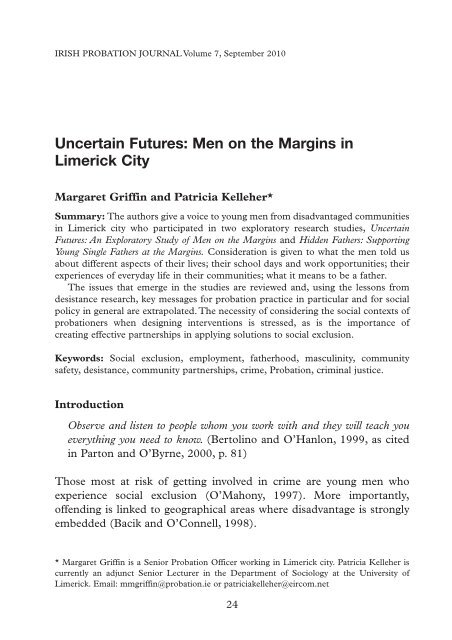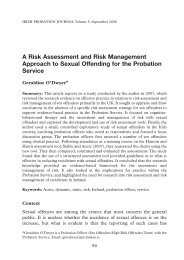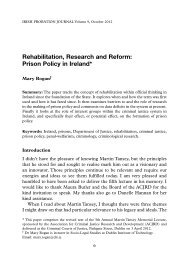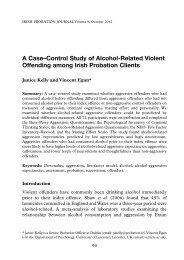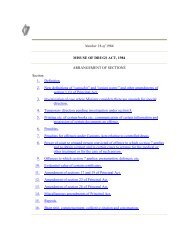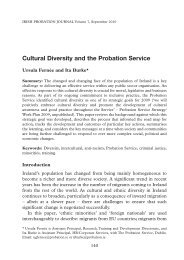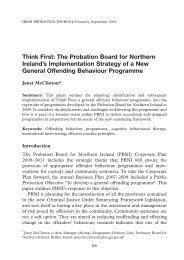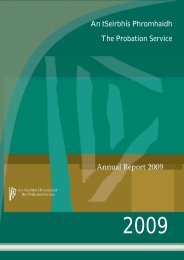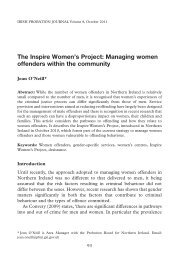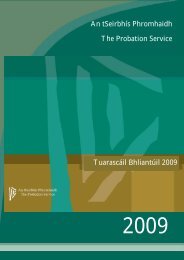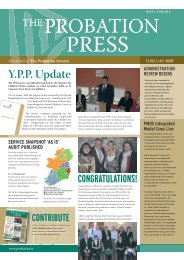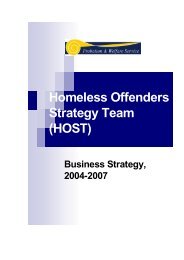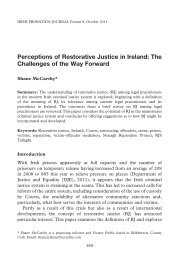Uncertain Futures: Men on the Margins in Limerick City
Uncertain Futures: Men on the Margins in Limerick City
Uncertain Futures: Men on the Margins in Limerick City
Create successful ePaper yourself
Turn your PDF publications into a flip-book with our unique Google optimized e-Paper software.
IRISH PROBATION JOURNAL Volume 7, September 2010<str<strong>on</strong>g>Uncerta<strong>in</strong></str<strong>on</strong>g> <str<strong>on</strong>g>Futures</str<strong>on</strong>g>: <str<strong>on</strong>g>Men</str<strong>on</strong>g> <strong>on</strong> <strong>the</strong> <strong>Marg<strong>in</strong>s</strong> <strong>in</strong><strong>Limerick</strong> <strong>City</strong>Margaret Griff<strong>in</strong> and Patricia Kelleher*Summary: The authors give a voice to young men from disadvantaged communities<strong>in</strong> <strong>Limerick</strong> city who participated <strong>in</strong> two exploratory research studies, <str<strong>on</strong>g>Uncerta<strong>in</strong></str<strong>on</strong>g><str<strong>on</strong>g>Futures</str<strong>on</strong>g>: An Exploratory Study of <str<strong>on</strong>g>Men</str<strong>on</strong>g> <strong>on</strong> <strong>the</strong> <strong>Marg<strong>in</strong>s</strong> and Hidden Fa<strong>the</strong>rs: Support<strong>in</strong>gYoung S<strong>in</strong>gle Fa<strong>the</strong>rs at <strong>the</strong> <strong>Marg<strong>in</strong>s</strong>. C<strong>on</strong>siderati<strong>on</strong> is given to what <strong>the</strong> men told usabout different aspects of <strong>the</strong>ir lives; <strong>the</strong>ir school days and work opportunities; <strong>the</strong>irexperiences of everyday life <strong>in</strong> <strong>the</strong>ir communities; what it means to be a fa<strong>the</strong>r.The issues that emerge <strong>in</strong> <strong>the</strong> studies are reviewed and, us<strong>in</strong>g <strong>the</strong> less<strong>on</strong>s fromdesistance research, key messages for probati<strong>on</strong> practice <strong>in</strong> particular and for socialpolicy <strong>in</strong> general are extrapolated. The necessity of c<strong>on</strong>sider<strong>in</strong>g <strong>the</strong> social c<strong>on</strong>texts ofprobati<strong>on</strong>ers when design<strong>in</strong>g <strong>in</strong>terventi<strong>on</strong>s is stressed, as is <strong>the</strong> importance ofcreat<strong>in</strong>g effective partnerships <strong>in</strong> apply<strong>in</strong>g soluti<strong>on</strong>s to social exclusi<strong>on</strong>.Keywords: Social exclusi<strong>on</strong>, employment, fa<strong>the</strong>rhood, mascul<strong>in</strong>ity, communitysafety, desistance, community partnerships, crime, Probati<strong>on</strong>, crim<strong>in</strong>al justice.Introducti<strong>on</strong>Observe and listen to people whom you work with and <strong>the</strong>y will teach youeveryth<strong>in</strong>g you need to know. (Bertol<strong>in</strong>o and O’Hanl<strong>on</strong>, 1999, as cited<strong>in</strong> Part<strong>on</strong> and O’Byrne, 2000, p. 81)Those most at risk of gett<strong>in</strong>g <strong>in</strong>volved <strong>in</strong> crime are young men whoexperience social exclusi<strong>on</strong> (O’Mah<strong>on</strong>y, 1997). More importantly,offend<strong>in</strong>g is l<strong>in</strong>ked to geographical areas where disadvantage is str<strong>on</strong>glyembedded (Bacik and O’C<strong>on</strong>nell, 1998).* Margaret Griff<strong>in</strong> is a Senior Probati<strong>on</strong> Officer work<strong>in</strong>g <strong>in</strong> <strong>Limerick</strong> city. Patricia Kelleher iscurrently an adjunct Senior Lecturer <strong>in</strong> <strong>the</strong> Department of Sociology at <strong>the</strong> University of<strong>Limerick</strong>. Email: mmgriff<strong>in</strong>@probati<strong>on</strong>.ie or patriciakelleher@eircom.net24
<str<strong>on</strong>g>Uncerta<strong>in</strong></str<strong>on</strong>g> <str<strong>on</strong>g>Futures</str<strong>on</strong>g> 25The 26 young men who c<strong>on</strong>tributed to <strong>the</strong> studies live <strong>in</strong> some of <strong>the</strong>most disadvantaged areas <strong>in</strong> Ireland and are <strong>in</strong>volved <strong>in</strong>, or are at risk ofbecom<strong>in</strong>g <strong>in</strong>volved <strong>in</strong>, crime. These young men tell us of <strong>the</strong> deep lack ofrespect that <strong>the</strong>y experience; <strong>the</strong>y portray lives blighted by exclusi<strong>on</strong> andcharacterised by underachievement at school, <strong>in</strong>ability to f<strong>in</strong>d work,boredom, lack of safe access to public spaces, fears for <strong>the</strong>ir own safetyand that of <strong>the</strong>ir families, and exposure to trauma.The men also articulate what is important to <strong>the</strong>m: <strong>the</strong>ir localities andcommunities; <strong>the</strong>ir families, particularly <strong>the</strong>ir children; access to tra<strong>in</strong><strong>in</strong>gand employment; opportunities to engage <strong>in</strong> sport<strong>in</strong>g and o<strong>the</strong>r leisureactivities. They voice hopes and aspirati<strong>on</strong>s that reflect <strong>the</strong> dom<strong>in</strong>antcultural def<strong>in</strong>iti<strong>on</strong>s of be<strong>in</strong>g a man, without hav<strong>in</strong>g access to <strong>the</strong>opportunities to fulfil <strong>the</strong>ir expectati<strong>on</strong>s to achieve breadw<strong>in</strong>ner statusand to enact <strong>the</strong> provider role. 1The studies <strong>on</strong> which this paper is based were c<strong>on</strong>ducted to elicit <strong>the</strong>views of a cohort of <strong>the</strong> populati<strong>on</strong> who are rarely asked about how <strong>the</strong>ysee <strong>the</strong> world and what’s important to <strong>the</strong>m. It was also recognised that<strong>the</strong>y were a group who did not usually engage with services <strong>in</strong> <strong>the</strong> cityunless compelled to do so by <strong>the</strong> courts. They were perceived anddescribed by agencies across <strong>the</strong> community/statutory services as ‘hardto reach’.Ascerta<strong>in</strong><strong>in</strong>g <strong>the</strong>ir views and needs was c<strong>on</strong>sidered to be an importantstep <strong>in</strong> hav<strong>in</strong>g <strong>the</strong>ir needs identified and met. In additi<strong>on</strong>, <strong>the</strong> stories of<strong>the</strong>se young men were c<strong>on</strong>sidered to be a significant part of <strong>the</strong> story of<strong>the</strong> city as it embarked <strong>on</strong> a regenerati<strong>on</strong> process. 2While some of <strong>the</strong> picture that is pa<strong>in</strong>ted may be specific to <strong>Limerick</strong>city, <strong>the</strong> voices that emerge <strong>in</strong> this paper will have a str<strong>on</strong>g res<strong>on</strong>ance forprobati<strong>on</strong> practiti<strong>on</strong>ers who are familiar with <strong>the</strong> challenges that faceyoung men <strong>in</strong> <strong>the</strong>ir efforts to desist from offend<strong>in</strong>g and achieve social<strong>in</strong>clusi<strong>on</strong>. In present<strong>in</strong>g social marg<strong>in</strong>alisati<strong>on</strong> as experienced by <strong>the</strong>young men, this study represents <strong>on</strong>e of <strong>the</strong> rare opportunities, <strong>in</strong> anIrish c<strong>on</strong>text, for <strong>the</strong>se voices to be heard.1 While <strong>the</strong> authors appreciate that this representati<strong>on</strong> of hegem<strong>on</strong>ic mascul<strong>in</strong>ity is notunproblematic, it is bey<strong>on</strong>d <strong>the</strong> scope of this article to exam<strong>in</strong>e it fur<strong>the</strong>r.2 See www.limerickregenerati<strong>on</strong>.ie for more <strong>in</strong>formati<strong>on</strong>.
26 Margaret Griff<strong>in</strong> and Patricia KelleherBackgroundThis paper is based <strong>on</strong> two exploratory studies, <str<strong>on</strong>g>Uncerta<strong>in</strong></str<strong>on</strong>g> <str<strong>on</strong>g>Futures</str<strong>on</strong>g>(Kelleher Associates and O’C<strong>on</strong>nor, 2007) and Hidden Fa<strong>the</strong>rs (KelleherAssociates and O’C<strong>on</strong>nor, 2008). Eighteen men participated <strong>in</strong> <str<strong>on</strong>g>Uncerta<strong>in</strong></str<strong>on</strong>g><str<strong>on</strong>g>Futures</str<strong>on</strong>g>; key <strong>the</strong>mes explored <strong>in</strong>cluded:• school days• work opportunities• everyday life <strong>in</strong> <strong>the</strong>ir communities• what it means to be a fa<strong>the</strong>r.The sec<strong>on</strong>d study, Hidden Fa<strong>the</strong>rs, which <strong>in</strong>terviewed 12 n<strong>on</strong>-residentfa<strong>the</strong>rs, builds <strong>on</strong> <strong>the</strong> f<strong>in</strong>d<strong>in</strong>gs of <strong>the</strong> first and explores <strong>in</strong> a more <strong>in</strong>-depthway <strong>the</strong> experiences of young men as s<strong>in</strong>gle fa<strong>the</strong>rs. Four of <strong>the</strong> men hadbeen <strong>in</strong>terviewed for <strong>the</strong> first study, thus giv<strong>in</strong>g an overall number of 26young men between <strong>the</strong> two.<str<strong>on</strong>g>Men</str<strong>on</strong>g> were selected for <strong>the</strong> research <strong>on</strong> <strong>the</strong> basis of age and locati<strong>on</strong>.All were between 18 and 33 years and <strong>the</strong>y all come from, or reside <strong>in</strong>,some of <strong>the</strong> most socio-ec<strong>on</strong>omically disadvantaged local authorityhous<strong>in</strong>g estates <strong>in</strong> <strong>the</strong> State:<strong>Limerick</strong> city is by far <strong>the</strong> most disadvantaged local authority area <strong>in</strong><strong>the</strong> regi<strong>on</strong> and <strong>the</strong> sec<strong>on</strong>d most disadvantaged county <strong>in</strong> Ireland as awhole. The relative deprivati<strong>on</strong> of <strong>Limerick</strong> city has steadily <strong>in</strong>creasedover <strong>the</strong> past fifteen years from a score of –2.4 <strong>in</strong> 1991 to –7.9 <strong>in</strong> 2006.(PAUL Partnership, 2006) 3The statistics for <strong>the</strong> areas <strong>in</strong> <strong>the</strong> study tell <strong>the</strong>ir own story:unemployment is five times <strong>the</strong> nati<strong>on</strong>al average (Fitzgerald, 2007, p. 5);between 46.7% and 55.1% of <strong>the</strong> adult populati<strong>on</strong> has <strong>on</strong>ly primaryeducati<strong>on</strong> (<strong>the</strong> nati<strong>on</strong>al average is 18.9%); <strong>the</strong> proporti<strong>on</strong> of l<strong>on</strong>e-parentfamilies 4 ranges from 57% to 64% compared to a nati<strong>on</strong>al figure of 21%;social welfare dependency is high, with large numbers of households <strong>in</strong>3 PAUL Partnership is an organisati<strong>on</strong> made up of communities, state agencies, social partners,voluntary groups and elected representatives work<strong>in</strong>g with local communities that havebenefited least from ec<strong>on</strong>omic and social development. It aims to promote social <strong>in</strong>clusi<strong>on</strong> andimprove <strong>the</strong> quality of life of <strong>the</strong> people. PAUL stands for People aga<strong>in</strong>st Unemployment <strong>in</strong><strong>Limerick</strong>. www.paulpartnership.ie4 L<strong>on</strong>e-parent families are def<strong>in</strong>ed as family units headed by a s<strong>in</strong>gle parent where <strong>the</strong>re is atleast <strong>on</strong>e dependent child under <strong>the</strong> age of 15 years.
<str<strong>on</strong>g>Uncerta<strong>in</strong></str<strong>on</strong>g> <str<strong>on</strong>g>Futures</str<strong>on</strong>g> 27<strong>the</strong> areas be<strong>in</strong>g welfare-dependent 5 (PAUL Partnership, 2006). Theseareas are also <strong>the</strong> focus of <strong>the</strong> <strong>Limerick</strong> Regenerati<strong>on</strong> Project, which wasestablished to address <strong>the</strong> chr<strong>on</strong>ic and c<strong>on</strong>centrated disadvantageidentified <strong>in</strong> <strong>the</strong> Fitzgerald Report (Fitzgerald, 2007).In additi<strong>on</strong> to <strong>the</strong> above dismal picture of disadvantage and depriva -ti<strong>on</strong>, <strong>the</strong> city has come to nati<strong>on</strong>al attenti<strong>on</strong> because of <strong>the</strong> level ofcrim<strong>in</strong>al and <strong>in</strong>ter-family feud<strong>in</strong>g that has taken place <strong>in</strong> recent years,result<strong>in</strong>g <strong>in</strong> a serious level of violence, <strong>in</strong>timidati<strong>on</strong> and fear, particularlyfor <strong>the</strong> communities menti<strong>on</strong>ed above.In design<strong>in</strong>g <strong>the</strong> research project care was taken to ensure that it wasethical and n<strong>on</strong>-exploitative and that it did not fur<strong>the</strong>r stigmatise or label<strong>the</strong> young men <strong>in</strong>volved. Prior to engag<strong>in</strong>g <strong>in</strong> semi-structured <strong>in</strong>terviews<strong>the</strong> men were given a letter outl<strong>in</strong><strong>in</strong>g <strong>the</strong> purpose of <strong>the</strong> research and <strong>the</strong>yeach signed a c<strong>on</strong>sent form. Interviews were c<strong>on</strong>ducted by tworesearchers and were about 45 m<strong>in</strong>utes <strong>in</strong> durati<strong>on</strong>. The participati<strong>on</strong> of<strong>the</strong> <strong>in</strong>terviewees was voluntary, no <strong>in</strong>ducements were offered and <strong>the</strong>men were made aware that <strong>the</strong>y could term<strong>in</strong>ate <strong>the</strong> <strong>in</strong>terview at anystage. The <strong>in</strong>terviewees have all been given aliases to protect <strong>the</strong>iridentity, and all identify<strong>in</strong>g <strong>in</strong>formati<strong>on</strong> has been removed.School daysAlmost all of <strong>the</strong> men <strong>in</strong>terviewed for <str<strong>on</strong>g>Uncerta<strong>in</strong></str<strong>on</strong>g> <str<strong>on</strong>g>Futures</str<strong>on</strong>g> recounteddifficulties <strong>in</strong> manag<strong>in</strong>g <strong>the</strong> school envir<strong>on</strong>ment. Critically, 13 of <strong>the</strong> 18men <strong>in</strong>terviewed left school without educati<strong>on</strong>al qualificati<strong>on</strong>s, 6 thusmak<strong>in</strong>g what O’D<strong>on</strong>nell and Sharpe (2000) refer to as ‘careerless transi -ti<strong>on</strong>s’, with access <strong>on</strong>ly to low-paid <strong>in</strong>secure employment opportunities.The men described three broad areas where <strong>the</strong>y experienceddifficulty <strong>in</strong> <strong>the</strong> school envir<strong>on</strong>ment:1. Special needs not be<strong>in</strong>g identified: Declan, now 20 years old, leftschool at 18 without pass<strong>in</strong>g his Junior Certificate 7 and he feels5 The exact figure for social welfare dependency is difficult to calculate as it <strong>in</strong>cludes numbers<strong>on</strong> <strong>the</strong> live register, l<strong>on</strong>e parents <strong>in</strong> receipt of state allowances, people with disabilities, thoseunable to work due to illness and o<strong>the</strong>rs.6 This is <strong>in</strong> keep<strong>in</strong>g with o<strong>the</strong>r studies which <strong>in</strong>dicate that males from lower socio-ec<strong>on</strong>omicgroup<strong>in</strong>gs are <strong>the</strong> least successful educati<strong>on</strong>ally (Smyth and Hann<strong>on</strong>, 2000)7 The Junior Certificate exam<strong>in</strong>ati<strong>on</strong> is held at <strong>the</strong> end of <strong>the</strong> Junior Cycle <strong>in</strong> post-primaryschools. Students normally sit for it at <strong>the</strong> age of 14 or 15, after three years of post-primaryeducati<strong>on</strong>. www.exam<strong>in</strong>ati<strong>on</strong>s.ie/<strong>in</strong>dex.php?l=en&mc=ca&sc=sc
28 Margaret Griff<strong>in</strong> and Patricia Kelleheraggrieved that his learn<strong>in</strong>g disability was not detected until after heleft school:I was not diagnosed until after I left school … I knew that I had difficulties.I got bullied and harassed at school because of my learn<strong>in</strong>g difficulties.There is a lack of services for a pers<strong>on</strong> with a learn<strong>in</strong>g disability. There isno centre <strong>in</strong> <strong>Limerick</strong>.2. Experience of childhood trauma: Niall, who left school at 13,recounts his experience:My fa<strong>the</strong>r had a mental illness and committed suicide. Hav<strong>in</strong>g no fa<strong>the</strong>rand <strong>the</strong> envir<strong>on</strong>ment I grew up <strong>in</strong> led me astray. I was hang<strong>in</strong>g around <strong>the</strong>streets and got <strong>in</strong>to trouble with <strong>the</strong> law and left school. I was too busywant<strong>in</strong>g to be <strong>on</strong>e of <strong>the</strong> men.3. Inability to make <strong>the</strong> transiti<strong>on</strong> from primary to sec<strong>on</strong>daryschool: V<strong>in</strong>ce (23 years old) makes <strong>the</strong> follow<strong>in</strong>g observati<strong>on</strong>:Primary school was OK. Sec<strong>on</strong>dary school was bor<strong>in</strong>g. We had all differentteachers. I left school at 14 and went to a special school.Some men identified how <strong>the</strong>y coped with <strong>the</strong> school envir<strong>on</strong>ment bybe<strong>in</strong>g rebellious and refus<strong>in</strong>g to accept <strong>the</strong> teacher’s authority:We were all messers. I was thrown out of school. I had got suspended a fewtimes. They said that <strong>the</strong>y would take me back if I signed a form for goodbehaviour. I wouldn’t sign it. (Joe)This statement, as well as o<strong>the</strong>rs where men described <strong>the</strong>mselves as‘blaggards’, is <strong>in</strong> keep<strong>in</strong>g with research that <strong>in</strong>dicates that ‘boys are morelikely to externalise <strong>the</strong>ir difficulties and this will impact <strong>on</strong> <strong>the</strong>classroom’ (Kolv<strong>in</strong> et al., 1990, as cited <strong>in</strong> Cleary, Corbett, Galv<strong>in</strong> andWall, 2004, p. 33).Some of <strong>the</strong> young men, hav<strong>in</strong>g left ma<strong>in</strong>stream educati<strong>on</strong>prematurely, transferred to special schools or community tra<strong>in</strong><strong>in</strong>gworkshops where <strong>the</strong>y fared somewhat better. They identified smallgroups and <strong>in</strong>dividual attenti<strong>on</strong> as important factors that facilitated <strong>the</strong>irlearn<strong>in</strong>g. Davy also talks about <strong>the</strong> subject choice <strong>on</strong> offer:I went to a community tra<strong>in</strong><strong>in</strong>g workshop for three years and did woodworkand mechanics and English, computers and life skills. It was brilliant. Ilearned to read and write.
<str<strong>on</strong>g>Uncerta<strong>in</strong></str<strong>on</strong>g> <str<strong>on</strong>g>Futures</str<strong>on</strong>g> 29While <strong>the</strong> men developed basic skills <strong>in</strong> both <strong>the</strong> special schools and <strong>the</strong>community tra<strong>in</strong><strong>in</strong>g workshops, <strong>the</strong>y did not atta<strong>in</strong> <strong>the</strong> necessaryeducati<strong>on</strong>al qualificati<strong>on</strong>s to get an apprenticeship or a ‘decent job’.Some of <strong>the</strong> men, particularly <strong>the</strong> younger <strong>on</strong>es, were attempt<strong>in</strong>g torebuild <strong>the</strong>ir careers by attend<strong>in</strong>g community-based projects specificallydesigned to enable <strong>the</strong>m to atta<strong>in</strong> educati<strong>on</strong>al qualificati<strong>on</strong>s. 8 Thecomments of <strong>the</strong> young men who attended <strong>the</strong>se projects were bothpositive and future-focused.Joe, who is 19, left school at 15 and he is now attend<strong>in</strong>g a communitybasedprogramme where he is study<strong>in</strong>g for his Leav<strong>in</strong>g CertificateApplied 9 (LCA); he hopes to get a trade, preferably as a plumber. Dylanalso hopes to study for <strong>the</strong> LCA. He states:I left school at 15. I thought that I would be better off work<strong>in</strong>g. I so<strong>on</strong> foundout that <strong>the</strong>re are few well-paid jobs open to young men. For a job <strong>in</strong> securityyou need educati<strong>on</strong> and <strong>the</strong> Junior Cert. I want to do <strong>the</strong> Leav<strong>in</strong>g Cert. Ifthis project was not here I would be <strong>in</strong> trouble.These projects foster a pers<strong>on</strong>-centred, relati<strong>on</strong>al approach to learn<strong>in</strong>gand adopt models that are participatory and that affirm <strong>the</strong> self-esteemof <strong>the</strong> young people. Joe makes <strong>the</strong> follow<strong>in</strong>g observati<strong>on</strong>s:The project is very different from school where you were just sitt<strong>in</strong>g <strong>in</strong> aclassroom. Here it is relaxed. You call <strong>the</strong> teacher by <strong>the</strong> first name. They areyour friends. You know that <strong>the</strong>y care about you. There is a need for a lotmore projects like this. A lot of people are wait<strong>in</strong>g to get <strong>in</strong>.These community-based projects were also significant <strong>in</strong> terms ofbuild<strong>in</strong>g productive alliances outside of <strong>the</strong> communities, whe<strong>the</strong>r this<strong>in</strong>volved l<strong>in</strong>k<strong>in</strong>g with colleges or prospective employers. 10 Jas<strong>on</strong>’sc<strong>on</strong>tributi<strong>on</strong> makes this po<strong>in</strong>t very succ<strong>in</strong>ctly:8 A good example of this type of project is Ceim ar Cheim <strong>in</strong> Moyross, funded by <strong>the</strong> Probati<strong>on</strong>Service, which places a big emphasis <strong>on</strong> identify<strong>in</strong>g progressi<strong>on</strong> routes for its participants.9 See http://lca.slss.ie/faq.html for more <strong>in</strong>formati<strong>on</strong> <strong>on</strong> this qualificati<strong>on</strong>.10 The ability to reach bey<strong>on</strong>d your immediate sphere of <strong>in</strong>fluence to have your needs identifiedand met is referred to <strong>in</strong> <strong>the</strong> literature as ‘bridg<strong>in</strong>g social capital’: for a very accessibleexplanati<strong>on</strong> see DeCleir (2003).
30 Margaret Griff<strong>in</strong> and Patricia KelleherIt is hard to get anyth<strong>in</strong>g or to get anywhere. You need <strong>the</strong> outside c<strong>on</strong>tact –that is where <strong>the</strong> project is important.EmploymentThe American sociologist S.M. Miller said that we live <strong>in</strong> what he called<strong>the</strong> ‘credential’ society (Miller, 1967; as cited <strong>in</strong> Miller and Savoie,2002), where access to employment and social and ec<strong>on</strong>omic security arestr<strong>on</strong>gly correlated with educati<strong>on</strong>al credentials. 11 It is argued that <strong>the</strong>opportunity to perform <strong>the</strong> ‘breadw<strong>in</strong>ner’ role is key to a man’s sense ofidentity with<strong>in</strong> his family and community, particularly for work<strong>in</strong>g-classmen (Hearn, 1998, as cited <strong>in</strong> Cleary et al., 2004).Labour-force participati<strong>on</strong> is also a significant determ<strong>in</strong>ant of o<strong>the</strong>rlife opportunities, such as sett<strong>in</strong>g up an <strong>in</strong>dependent home andcommitt<strong>in</strong>g to a l<strong>on</strong>g-term relati<strong>on</strong>ship and hav<strong>in</strong>g children (Webster,1997a, as cited <strong>in</strong> Cleary et al., 2004). The men who participated <strong>in</strong> thisstudy espoused <strong>the</strong> same values as <strong>the</strong> wider culture <strong>in</strong> want<strong>in</strong>g a ‘decentjob’ to support a family. The fact that <strong>the</strong>y were unequivocal about <strong>the</strong>importance of paid employment is particularly poignant when <strong>on</strong>ec<strong>on</strong>siders <strong>the</strong> obstacles <strong>the</strong>y face <strong>in</strong> access<strong>in</strong>g work:It emoti<strong>on</strong>ally affects a man that he cannot support a family. <str<strong>on</strong>g>Men</str<strong>on</strong>g> value<strong>the</strong>mselves <strong>in</strong> work. Without work many feel useless. It is an empt<strong>in</strong>ess feel<strong>in</strong>g.(Declan)When my kids are asked ‘what does your fa<strong>the</strong>r do?’ I would like <strong>the</strong>m to beable to say that I do someth<strong>in</strong>g. I would not be able to work full-time due todepressi<strong>on</strong> but I would like to get <strong>on</strong> a CE 12 scheme. (Niall, 29 years old)Every<strong>on</strong>e needs work. You need m<strong>on</strong>ey com<strong>in</strong>g <strong>in</strong>. You get lazy and depressedwhen you are stuck <strong>in</strong> <strong>the</strong> house. (Chris, 25 years old)11 Access to apprenticeships has been a traditi<strong>on</strong>al route for work<strong>in</strong>g-class men to progress fromlow-paid, <strong>in</strong>secure employment to skilled employment. Educati<strong>on</strong>al credentials are now neededto enter an apprenticeship programme, thus mak<strong>in</strong>g this route no l<strong>on</strong>ger available to manywork<strong>in</strong>g-class men.12 Community Employment is an employment and tra<strong>in</strong><strong>in</strong>g programme that helps l<strong>on</strong>g-termunemployed people to re-enter <strong>the</strong> active workforce by break<strong>in</strong>g <strong>the</strong>ir experience ofunemployment through a return to work rout<strong>in</strong>e. CE schemes operate <strong>on</strong> <strong>the</strong> basis of a 20-hourwork<strong>in</strong>g week. See www.fas.ie/en/communities/community+employment/default.htm forfur<strong>the</strong>r <strong>in</strong>formati<strong>on</strong>.
<str<strong>on</strong>g>Uncerta<strong>in</strong></str<strong>on</strong>g> <str<strong>on</strong>g>Futures</str<strong>on</strong>g> 31In additi<strong>on</strong> to <strong>the</strong> problems ga<strong>in</strong><strong>in</strong>g employment because of <strong>the</strong>ir lack ofeducati<strong>on</strong>al qualificati<strong>on</strong>s, almost all of <strong>the</strong> men believed that discrim<strong>in</strong>a -ti<strong>on</strong> based <strong>on</strong> where <strong>the</strong>y lived was a barrier:You will never get a job if you are from here. They d<strong>on</strong>’t like people from here.They f<strong>in</strong>d it hard to trust you. It is unfair. (Davy)Some of <strong>the</strong> men had given up hope of gett<strong>in</strong>g work and spent <strong>the</strong>ir time‘hang<strong>in</strong>g around all day’ with little to do.Everyday life <strong>in</strong> disadvantaged communitiesMany of <strong>the</strong> men <strong>in</strong>terviewed for <strong>the</strong> study <strong>in</strong>dicated that <strong>the</strong>y feel astr<strong>on</strong>g sense of c<strong>on</strong>necti<strong>on</strong> to <strong>the</strong>ir local area, with <strong>on</strong>ly two stat<strong>in</strong>g that<strong>the</strong>y would like to move. The majority had sibl<strong>in</strong>gs, aunts, uncles ando<strong>the</strong>r extended family liv<strong>in</strong>g nearby and <strong>the</strong>y were highly <strong>in</strong>tegrated <strong>in</strong>to<strong>the</strong>ir communities.Some of <strong>the</strong> men recounted happy childhood memories:My fa<strong>the</strong>r used to take me fish<strong>in</strong>g and camp<strong>in</strong>g. (Philip)I was brought up <strong>in</strong> Moyross. I enjoyed it. Moyross has an all-wea<strong>the</strong>r <strong>in</strong>doorsoccer pitch, snooker, box<strong>in</strong>g club. I love soccer and hurl<strong>in</strong>g. (William)It was a great place to grow up <strong>in</strong>. I always had someth<strong>in</strong>g to do. I lovedhandball and hurl<strong>in</strong>g. I used to hang around at <strong>the</strong> shop. (Dave)St Mary’s was a great place to grow up. There were regattas <strong>on</strong> <strong>the</strong> river. Youcould hang around for hours. (Niall)Twelve of <strong>the</strong> men <strong>in</strong>terviewed expressed a keen <strong>in</strong>terest <strong>in</strong> sport,particularly soccer and Gaelic games, and a number had participated <strong>in</strong>various sports at a high level.Some men expla<strong>in</strong>ed <strong>the</strong> importance of keep<strong>in</strong>g and car<strong>in</strong>g for horses:I love horses. I love just sitt<strong>in</strong>g <strong>the</strong>re watch<strong>in</strong>g <strong>the</strong>m. I love watch<strong>in</strong>g <strong>the</strong>mtrott<strong>in</strong>g or rac<strong>in</strong>g. (Jas<strong>on</strong>)
32 Margaret Griff<strong>in</strong> and Patricia KelleherBut this activity was not without difficulties: 13Every<strong>on</strong>e loves horses. I love horses. All I wanted was horses. The Gardaí 14and <strong>the</strong> pound took <strong>the</strong>m. They brought <strong>the</strong>m to Cork. (Paddy)Everyday activity for many <strong>in</strong>terviewed, if <strong>the</strong>y were not <strong>in</strong>volved <strong>in</strong>community projects, c<strong>on</strong>sisted of ‘hang<strong>in</strong>g around, do<strong>in</strong>g noth<strong>in</strong>g <strong>in</strong>particular’. V<strong>in</strong>ce said:There is f*** all to do here now. It is a dive.Several of <strong>the</strong> men described stay<strong>in</strong>g <strong>in</strong> bed until midday and spend<strong>in</strong>g<strong>the</strong> afterno<strong>on</strong> watch<strong>in</strong>g televisi<strong>on</strong> at a friend’s house. The weekendsc<strong>on</strong>sist of gett<strong>in</strong>g a ‘few cans’ and play<strong>in</strong>g <strong>the</strong> Playstati<strong>on</strong> with friends.Perhaps not surpris<strong>in</strong>gly, <strong>in</strong> <strong>the</strong> c<strong>on</strong>text of <strong>Limerick</strong>, <strong>the</strong> predom<strong>in</strong>antfocus of attenti<strong>on</strong> for <strong>the</strong> young men <strong>in</strong>terviewed <strong>in</strong> this study was <strong>the</strong>impact of <strong>the</strong> feuds <strong>on</strong> life <strong>in</strong> <strong>the</strong> communities. There is historicalevidence that <strong>in</strong>ter-family feuds have been a feature of <strong>Limerick</strong> fordecades and <strong>the</strong>y precede <strong>the</strong> emergence of illicit drugs <strong>on</strong> <strong>the</strong> streets of<strong>the</strong> city. However, <strong>the</strong> level and extent of <strong>the</strong> violence associated with <strong>the</strong>feuds has escalated s<strong>in</strong>ce local families became <strong>in</strong>volved <strong>in</strong> <strong>the</strong> drugstrade <strong>in</strong> <strong>the</strong> 1990s. The pervasiveness of <strong>the</strong> feuds and <strong>the</strong> effects of anillicit drug trade were encapsulated <strong>in</strong> Paddy’s comment:Drugs have broken us. Drugs changed everyth<strong>in</strong>g <strong>in</strong> our community.Through greed and power <strong>the</strong> whole town is torn apart.High-profile events, such as murders and shoot<strong>in</strong>gs, br<strong>in</strong>g <strong>the</strong> attenti<strong>on</strong>of <strong>the</strong> nati<strong>on</strong>al media, but it is <strong>the</strong> <strong>on</strong>go<strong>in</strong>g, relentless anti-socialbehaviour, violence and <strong>in</strong>timidati<strong>on</strong> that impacts so negatively <strong>on</strong>people’s lives and creates fear and anxiety. Many studies po<strong>in</strong>t to <strong>the</strong>importance of <strong>the</strong> street (Whyte, 1943) and <strong>the</strong> pub (Willott and Griff<strong>in</strong>,13 The keep<strong>in</strong>g of horses has been rendered very difficult, if not impossible, <strong>in</strong> urban areas s<strong>in</strong>ce<strong>the</strong> <strong>in</strong>troducti<strong>on</strong> of <strong>the</strong> C<strong>on</strong>trol of Horses Act 1996. This Act gives local authorities <strong>the</strong> powerto issue licences to horse owners under certa<strong>in</strong> c<strong>on</strong>diti<strong>on</strong>s <strong>in</strong> <strong>the</strong>ir ‘c<strong>on</strong>trol areas’. The fact thatsome people have persisted <strong>in</strong> keep<strong>in</strong>g horses despite not be<strong>in</strong>g able to meet <strong>the</strong> c<strong>on</strong>diti<strong>on</strong>sstipulated has resulted <strong>in</strong> tensi<strong>on</strong>s between horse owners and <strong>the</strong> authorities.14 An Garda Síochána is <strong>the</strong> nati<strong>on</strong>al police service, colloquially referred to as <strong>the</strong> Gardaí orGuards.
<str<strong>on</strong>g>Uncerta<strong>in</strong></str<strong>on</strong>g> <str<strong>on</strong>g>Futures</str<strong>on</strong>g> 331996) for work<strong>in</strong>g-class and unemployed men. One of <strong>the</strong> less obviouseffects of <strong>the</strong> feuds is <strong>the</strong> curtailment of access to public spaces for <strong>the</strong>men who recounted <strong>the</strong>ir experiences:I do not go to <strong>the</strong> pub. I am paranoid about fights. (Niall)You can’t walk around <strong>the</strong> road without look<strong>in</strong>g to see who is beh<strong>in</strong>d you; itgot very bad two to four years ago. (Jas<strong>on</strong>)You cannot salute people. You cannot talk to people. You d<strong>on</strong>’t know who youare talk<strong>in</strong>g to. (Joe)For many men, not hav<strong>in</strong>g a direct <strong>in</strong>volvement <strong>in</strong> <strong>the</strong> feud does notprovide any protecti<strong>on</strong>, and it can be dangerous to visit o<strong>the</strong>r work<strong>in</strong>gclassareas of <strong>the</strong> city:You cannot go <strong>in</strong>to town. You cannot go <strong>in</strong>to ano<strong>the</strong>r community, even if youare neutral and not <strong>in</strong>volved. It is too dangerous. If you are seen mov<strong>in</strong>garound, some<strong>on</strong>e would th<strong>in</strong>k that you are deal<strong>in</strong>g <strong>in</strong> drugs. (Dave)A friend of m<strong>in</strong>e was stabbed <strong>in</strong> <strong>the</strong> lungs, because his nephew was <strong>in</strong>volved<strong>in</strong> <strong>the</strong> feud. (Niall)The comment by Niall po<strong>in</strong>ts to a particularly s<strong>in</strong>ister aspect of <strong>the</strong> feuds<strong>in</strong> <strong>Limerick</strong>: it is not necessary to be <strong>in</strong>volved <strong>on</strong>eself to become a targetand <strong>the</strong> victim of violence. Crim<strong>in</strong>al elements with<strong>in</strong> <strong>the</strong> city, if unable toga<strong>in</strong> access to <strong>the</strong>ir <strong>in</strong>tended target, will pick <strong>on</strong> a vulnerable associate;an uncle, bro<strong>the</strong>r, nephew, friend or even neighbour will suffice. Theeffects of <strong>the</strong> feud go out <strong>in</strong> c<strong>on</strong>centric circles from those centrally<strong>in</strong>volved and impact <strong>on</strong> whole communities <strong>in</strong> <strong>the</strong> city.This is not c<strong>on</strong>f<strong>in</strong>ed to adults, as <strong>the</strong> men also identify <strong>the</strong> impact <strong>on</strong>children:When kids come home from school, families do not let <strong>the</strong>m play out <strong>on</strong> <strong>the</strong>roads. They could get caught up <strong>in</strong> an argument with a child from a feud<strong>in</strong>gfamily. Next th<strong>in</strong>g you would know is that you would have your w<strong>in</strong>dowsblown <strong>in</strong>. (Colm)What would help kids is to end <strong>the</strong> feud<strong>in</strong>g and let <strong>the</strong>m have <strong>the</strong>irchildhood.
34 Margaret Griff<strong>in</strong> and Patricia KelleherThe positi<strong>on</strong> of some women, who are <strong>in</strong> relati<strong>on</strong>ships with <strong>the</strong> drugdealers, is described:Women are ‘trophies’. The women cannot walk away or <strong>the</strong>y would be killed.They want <strong>the</strong> women as trophies and to give <strong>the</strong>m children. They own this<strong>on</strong>e and that <strong>on</strong>e. Most women live as s<strong>in</strong>gle parents. They [<strong>the</strong> men] arescumbags. (Mark)It was also acknowledged that some women are enticed <strong>in</strong>to relati<strong>on</strong>shipswith <strong>the</strong>se men because of <strong>the</strong> promise of material ga<strong>in</strong>s:The women are bought off by <strong>the</strong> men. They can pawn off [placate] <strong>the</strong>women with a new car and a holiday. (Niall)For some <strong>the</strong> <strong>on</strong>ly chance of keep<strong>in</strong>g yourself and your family safe is torelocate out of <strong>the</strong> area:If your family is <strong>in</strong>volved <strong>in</strong> <strong>the</strong> feud, <strong>the</strong> <strong>on</strong>ly way to protect <strong>the</strong> family is toget <strong>the</strong> family out. It is very hard to stop <strong>the</strong> feud. It has g<strong>on</strong>e <strong>on</strong> for too l<strong>on</strong>g.Too many have been killed. You cannot protect <strong>the</strong>m from guns. (Dylan)This sense of hopelessness was shared by o<strong>the</strong>rs:You cannot lead an ord<strong>in</strong>ary life. There are too many people look<strong>in</strong>g forrevenge. There is no end to <strong>the</strong> feuds. There are too many people dead.(Dave)Fa<strong>the</strong>rhood 15Although 10 of <strong>the</strong> 12 men <strong>in</strong>terviewed for Hidden Fa<strong>the</strong>rsacknowledged that <strong>the</strong>y had not planned to become a fa<strong>the</strong>r, all of <strong>the</strong>mexpressed a desire to reta<strong>in</strong> an <strong>in</strong>volvement <strong>in</strong> <strong>the</strong> care and rear<strong>in</strong>g of<strong>the</strong>ir children:It is <strong>the</strong> <strong>on</strong>e th<strong>in</strong>g you can have that no <strong>on</strong>e can take away. It is importantto carry <strong>on</strong> <strong>the</strong> bloodstream.15 This secti<strong>on</strong> is based almost exclusively <strong>on</strong> <strong>the</strong> study Hidden Fa<strong>the</strong>rs, which <strong>in</strong>terviewed 12men who were n<strong>on</strong>-resident fa<strong>the</strong>rs. The men who c<strong>on</strong>tributed to Hidden Fa<strong>the</strong>rs were notgiven aliases <strong>in</strong> <strong>the</strong> f<strong>in</strong>al report and so no name appears beside <strong>the</strong>ir statements <strong>in</strong> this paper.
36 Margaret Griff<strong>in</strong> and Patricia KelleherHowever, many of <strong>the</strong> men did take resp<strong>on</strong>sibility for c<strong>on</strong>tribut<strong>in</strong>gf<strong>in</strong>ancially to <strong>the</strong>ir child(ren). While <strong>the</strong>y did not have formalma<strong>in</strong>tenance arrangements <strong>in</strong> place <strong>the</strong>y bought food and clo<strong>the</strong>s andpaid for special occasi<strong>on</strong>s: 16I d<strong>on</strong>’t pay ma<strong>in</strong>tenance as such. I put m<strong>on</strong>ey aside each week. If she neededm<strong>on</strong>ey for <strong>the</strong> kids I would give it to herO<strong>the</strong>r men acknowledged significant deficits <strong>in</strong> <strong>the</strong>ir skills base when itcame to car<strong>in</strong>g for <strong>the</strong>ir child(ren), <strong>in</strong> perform<strong>in</strong>g household tasks and <strong>in</strong>relati<strong>on</strong> to emoti<strong>on</strong>al competence:When I am stressed out and <strong>the</strong> child is cry<strong>in</strong>g I cannot handle it. I give herm<strong>on</strong>ey to stop her cry<strong>in</strong>g.I would be too frightened to have <strong>the</strong> child overnight <strong>on</strong> my own when she isso young [1 year old]. I am no good at chang<strong>in</strong>g nappies. I would not bathher.Women relatives, particularly mo<strong>the</strong>rs, were identified as importantsources of support when it came to practical help:My mo<strong>the</strong>r is a legend. When I have access, <strong>the</strong> children are dropped aroundto <strong>the</strong> house at 12 <strong>in</strong> <strong>the</strong> morn<strong>in</strong>g. I would be <strong>in</strong> bed and she would look after<strong>the</strong>m.Six of <strong>the</strong> 12 young men described hav<strong>in</strong>g satisfactory access to <strong>the</strong>irchildren, four experienced <strong>the</strong>ir access arrangements as unsatisfactoryand two had no access. Five of <strong>the</strong> six fa<strong>the</strong>rs who had satisfactory access<strong>in</strong> place had good relati<strong>on</strong>ships with <strong>the</strong> mo<strong>the</strong>r of <strong>the</strong>ir child and <strong>the</strong>yhad arrived at an access agreement <strong>the</strong>mselves, without recourse to <strong>the</strong>courts. In all four cases where <strong>the</strong> access arrangement is c<strong>on</strong>sidered by<strong>the</strong> fa<strong>the</strong>rs to be unsatisfactory, relati<strong>on</strong>ships between <strong>the</strong> mo<strong>the</strong>r andfa<strong>the</strong>r are ‘hostile’ and trust between <strong>the</strong> parties has broken down.The fa<strong>the</strong>rs <strong>in</strong> this study also cited accommodati<strong>on</strong> difficulties andf<strong>in</strong>ancial c<strong>on</strong>stra<strong>in</strong>ts as obstacles to quality access:16 These <strong>in</strong>formal f<strong>in</strong>ancial arrangements are seen as a way of circumvent<strong>in</strong>g <strong>the</strong> regulati<strong>on</strong>srelat<strong>in</strong>g to possible deducti<strong>on</strong>s from <strong>the</strong> <strong>on</strong>e-parent family payment.
<str<strong>on</strong>g>Uncerta<strong>in</strong></str<strong>on</strong>g> <str<strong>on</strong>g>Futures</str<strong>on</strong>g> 37I would like to have my daughter overnight but I have no properaccommodati<strong>on</strong>. You have nowhere to go, nowhere to br<strong>in</strong>g <strong>the</strong> child. I walkby <strong>the</strong> lake feed<strong>in</strong>g <strong>the</strong> ducks.Many of <strong>the</strong> men did not know what <strong>the</strong>ir legal rights were <strong>in</strong> relati<strong>on</strong> toaccess or jo<strong>in</strong>t custody and o<strong>the</strong>rs lacked <strong>in</strong>formati<strong>on</strong> <strong>on</strong> whe<strong>the</strong>r <strong>the</strong>yhave a right to have <strong>the</strong>ir names <strong>on</strong> <strong>the</strong> birth certificate and what <strong>the</strong>c<strong>on</strong>sequence of do<strong>in</strong>g so might be.Implicati<strong>on</strong>s for probati<strong>on</strong> practice and support<strong>in</strong>g desistanceThe men who c<strong>on</strong>tributed to <strong>the</strong>se studies articulate clearly what isimportant to <strong>the</strong>m and <strong>the</strong>y also give clues as to how to develop servicesthat best suit <strong>the</strong>ir needs. What makes this clearly <strong>the</strong> bus<strong>in</strong>ess ofprobati<strong>on</strong> practiti<strong>on</strong>ers is <strong>the</strong> str<strong>on</strong>g correlati<strong>on</strong> between what <strong>the</strong> mensay about what is important to <strong>the</strong>m and <strong>the</strong> key messages from research<strong>in</strong>to when and how offenders desist from offend<strong>in</strong>g.Desistance 17 is def<strong>in</strong>ed <strong>in</strong> <strong>the</strong> literature as ceas<strong>in</strong>g to offend or ‘go<strong>in</strong>gstraight’ (Maruna, Porter and Carvalho, 2004); it is c<strong>on</strong>sidered to be astop–start process, characterised by ambivalence and vacillati<strong>on</strong>, ra<strong>the</strong>rthan a s<strong>in</strong>gle event (McNeill and Whyte, 2007). Evidence is emerg<strong>in</strong>g <strong>in</strong><strong>the</strong> research literature that desistance is l<strong>in</strong>ked with certa<strong>in</strong> life eventsassociated with maturati<strong>on</strong>al processes, such as family formati<strong>on</strong> andbecom<strong>in</strong>g a parent or secur<strong>in</strong>g employment (Samps<strong>on</strong> and Laub, 1993,as cited <strong>in</strong> Gadd & Farrall, 2004; Farrall, 2002; Lipsey, 1995, as cited <strong>in</strong>McCulloch, 2005). However, <strong>the</strong> subjective mean<strong>in</strong>g attached to <strong>the</strong>sesignificant life events is also c<strong>on</strong>sidered to be an important determ<strong>in</strong>antof <strong>the</strong>ir usefulness <strong>in</strong> support<strong>in</strong>g desistance from offend<strong>in</strong>g (Farrall,2002).Farrall (2002) alerts us to <strong>the</strong> need for probati<strong>on</strong> practice to target <strong>the</strong>social c<strong>on</strong>texts <strong>in</strong> which probati<strong>on</strong>ers f<strong>in</strong>d <strong>the</strong>mselves, and McCulloch(2005) sees <strong>the</strong> need for practiti<strong>on</strong>ers to make a ‘more activecommitment towards alter<strong>in</strong>g <strong>the</strong>se c<strong>on</strong>texts as a means of support<strong>in</strong>gchange’ (p. 17).It is a challenge for probati<strong>on</strong> practiti<strong>on</strong>ers to be alert to, andrecognise, <strong>the</strong> opportunities presented by life events to promote and17 Some of <strong>the</strong> literature makes <strong>in</strong>terest<strong>in</strong>g dist<strong>in</strong>cti<strong>on</strong>s between primary desistance andsec<strong>on</strong>dary desistance but it is bey<strong>on</strong>d <strong>the</strong> scope of this article to explore this fur<strong>the</strong>r. See Farralland Calverly (2006) and Healy and O’D<strong>on</strong>nell (2006).
38 Margaret Griff<strong>in</strong> and Patricia Kellehersupport desistance. However, it is <strong>in</strong>sufficient simply to wait foropportunities to present <strong>the</strong>mselves; <strong>the</strong>re is also a need to work activelyto create opportunities.As menti<strong>on</strong>ed above, life events have subjective mean<strong>in</strong>g for <strong>the</strong><strong>in</strong>dividuals <strong>in</strong>volved; practice must be underp<strong>in</strong>ned by <strong>the</strong> viewpo<strong>in</strong>t of<strong>the</strong> probati<strong>on</strong>er. In order to commit more actively to work<strong>in</strong>g to alter <strong>the</strong>social c<strong>on</strong>texts of <strong>the</strong> men, it is important to understand <strong>the</strong>ir frame ofreference and world view and to br<strong>in</strong>g <strong>in</strong>to play <strong>the</strong>ir own <strong>in</strong>formal<strong>the</strong>ory of change (Duncan, Hubble and Miller, 1997).Participatory Probati<strong>on</strong> supervisi<strong>on</strong>The men who c<strong>on</strong>tributed to <strong>the</strong>se studies give clear directi<strong>on</strong> aboutwhat is important to <strong>the</strong>m and <strong>the</strong>y give clues as to how to developservices that best suit <strong>the</strong>ir needs. They were able to recognise andarticulate <strong>the</strong> obstacles and challenges <strong>the</strong>y faced <strong>on</strong> a daily basis <strong>in</strong> <strong>the</strong>irstruggle for relevance, dignity and survival, and <strong>the</strong>y c<strong>on</strong>sistentlypresented <strong>the</strong>mselves as ‘knowledgeable human agents’ (Giddens, 1984,as cited <strong>in</strong> Rex, 1999) who can c<strong>on</strong>tribute to f<strong>in</strong>d<strong>in</strong>g soluti<strong>on</strong>s that workfor <strong>the</strong>m.Studies of effective probati<strong>on</strong> practice po<strong>in</strong>t to <strong>the</strong> value of active andparticipatory supervisory experiences for probati<strong>on</strong>ers, where <strong>the</strong>re issome effort at jo<strong>in</strong>t plann<strong>in</strong>g (Rex, 1999). This <strong>the</strong>me is also identified byMcCulloch (2005), who advocates that Probati<strong>on</strong> Officers adopt anactive commitment to work<strong>in</strong>g collaboratively with probati<strong>on</strong>ers. It isimperative for Probati<strong>on</strong> to l<strong>in</strong>k with <strong>the</strong> expertise of probati<strong>on</strong>ers, whocan def<strong>in</strong>e both <strong>the</strong> difficulties <strong>the</strong>y face and <strong>the</strong> soluti<strong>on</strong>s most likely tobe effective for <strong>the</strong>m.Participatory Probati<strong>on</strong> supervisi<strong>on</strong> plays an important role <strong>in</strong>spir<strong>in</strong>ghope, build<strong>in</strong>g <strong>on</strong> <strong>the</strong> strengths of <strong>in</strong>dividuals and l<strong>in</strong>k<strong>in</strong>g <strong>in</strong>dividuals tolife-enhanc<strong>in</strong>g supports and services. There is also evidence that thisapproach is valued by probati<strong>on</strong>ers, particularly those that attributechanges <strong>in</strong> <strong>the</strong>ir behaviour to <strong>the</strong>ir experience of probati<strong>on</strong> supervisi<strong>on</strong>(Rex, 1999).Access to employmentThe men were clear and unequivocal about <strong>the</strong> importance to <strong>the</strong>m ofatta<strong>in</strong><strong>in</strong>g ‘decent jobs’. Gett<strong>in</strong>g stable employment assists <strong>in</strong> <strong>the</strong>
<str<strong>on</strong>g>Uncerta<strong>in</strong></str<strong>on</strong>g> <str<strong>on</strong>g>Futures</str<strong>on</strong>g> 39formati<strong>on</strong> of ‘adult social b<strong>on</strong>ds’ and is a significant factor <strong>in</strong> support<strong>in</strong>gdesistance from offend<strong>in</strong>g (Rex, 1999; Farrall, 2002). The men alsorecognised that, without educati<strong>on</strong> or vocati<strong>on</strong>al credentials, withcrim<strong>in</strong>al histories and com<strong>in</strong>g from certa<strong>in</strong> locati<strong>on</strong>s, gett<strong>in</strong>g work wasgo<strong>in</strong>g to be a huge challenge for <strong>the</strong>m. Some of <strong>the</strong> younger men, whohad access to tra<strong>in</strong><strong>in</strong>g through local community-based projects, weremore optimistic than those <strong>in</strong> <strong>the</strong> over-23 age group, who had all but losthope.The Probati<strong>on</strong> Service, by hav<strong>in</strong>g regular and susta<strong>in</strong>ed c<strong>on</strong>tact withthis older group, is ideally situated to facilitate access to appropriatetra<strong>in</strong><strong>in</strong>g towards employment by forg<strong>in</strong>g str<strong>on</strong>g partnerships wi<strong>the</strong>ducati<strong>on</strong>al and tra<strong>in</strong><strong>in</strong>g providers and with <strong>the</strong> private sector to providelocally based educati<strong>on</strong> projects l<strong>in</strong>ked to progressi<strong>on</strong> routes toapprentice ships, fur<strong>the</strong>r educati<strong>on</strong> or mean<strong>in</strong>gful employment.In terms of design<strong>in</strong>g locally based educati<strong>on</strong> projects, <strong>the</strong> observa -ti<strong>on</strong>s of <strong>the</strong> men were aga<strong>in</strong> <strong>in</strong>structive. They advocated small groupswith a respectful, relati<strong>on</strong>al approach to teach<strong>in</strong>g and also a curriculumwith more emphasis <strong>on</strong> practical skills. While this approach to serviceprovisi<strong>on</strong> is resource-<strong>in</strong>tensive and <strong>the</strong>refore expensive to deliver, <strong>the</strong>costs must be offset aga<strong>in</strong>st <strong>the</strong> l<strong>on</strong>g-term costs to <strong>in</strong>dividuals, familiesand communities of not provid<strong>in</strong>g <strong>the</strong>se services.Use of leisure timeThere is a str<strong>on</strong>g relati<strong>on</strong>ship between unstructured use of time and <strong>the</strong>risk of reoffend<strong>in</strong>g. The men described boredom as a regular feature of<strong>the</strong>ir lives. While <strong>the</strong>y identified a keen <strong>in</strong>terest <strong>in</strong> sport, what becameobvious <strong>in</strong> discussi<strong>on</strong> with <strong>the</strong>m was <strong>the</strong> uneven spread of sport<strong>in</strong>g andrecreati<strong>on</strong>al facilities <strong>in</strong> <strong>the</strong> neighbourhoods. This po<strong>in</strong>t was made verysucc<strong>in</strong>ctly by <strong>the</strong> existence of a soccer academy <strong>in</strong> <strong>on</strong>e area that did nothave a soccer pitch.Involvement <strong>in</strong> sport, and all that this entails, could act as a protectivefactor <strong>in</strong> desist<strong>in</strong>g from offend<strong>in</strong>g. Moreover, sport represents an activity<strong>the</strong> men feel passi<strong>on</strong>ately about and it <strong>the</strong>refore provides an opportunityto <strong>the</strong> Probati<strong>on</strong> Service and o<strong>the</strong>r services to engage positively with<strong>the</strong>m. This may <strong>in</strong>volve advocat<strong>in</strong>g for <strong>the</strong>m to ga<strong>in</strong> access to facilities butcould also <strong>in</strong>clude, for example, a men’s health programme deliveredthrough <strong>the</strong> medium of sport.Care of horses is ano<strong>the</strong>r activity some of <strong>the</strong> men are very exercisedabout, and <strong>the</strong> significance of <strong>the</strong> relati<strong>on</strong>ship between <strong>the</strong> men and <strong>the</strong>ir
40 Margaret Griff<strong>in</strong> and Patricia Kelleherhorses, and <strong>the</strong> c<strong>on</strong>sequent impact <strong>on</strong> <strong>the</strong>ir physical, emoti<strong>on</strong>al andmental health, is not to be underestimated. Horse projects, which wouldenable men liv<strong>in</strong>g <strong>in</strong> urban areas to keep horses without <strong>the</strong> risk of be<strong>in</strong>g<strong>in</strong> breach of <strong>the</strong> C<strong>on</strong>trol of Horses Act 1996, 18 need to be developed. Thepotential to create tra<strong>in</strong><strong>in</strong>g and employment through well-designed andwell-managed horse projects is enormous, and would provide anopportunity to engage positively with men around an issue <strong>the</strong>y arepassi<strong>on</strong>ate about.GenerativityGenerativity is described as ‘<strong>the</strong> ability to transcend <strong>the</strong> immediate selfrelated<strong>in</strong>terests of <strong>the</strong> pers<strong>on</strong> <strong>in</strong> favour of a view of generati<strong>on</strong>s to come’and is also thought to be l<strong>in</strong>ked to desistance from offend<strong>in</strong>g (M<strong>on</strong>te,1995, as cited <strong>in</strong> Healy and O’D<strong>on</strong>nell, 2008, p. 27). There were clearstatements <strong>in</strong> <strong>the</strong> narratives of <strong>the</strong> men of c<strong>on</strong>cern for <strong>the</strong>ir children.However, <strong>the</strong> men also identified significant skills deficits <strong>in</strong> meet<strong>in</strong>g<strong>the</strong>ir ambiti<strong>on</strong> to be good parents, and particularly <strong>in</strong> <strong>the</strong>ir capacity tocare for <strong>the</strong>ir children and to perform household tasks.In <strong>the</strong> Hidden Fa<strong>the</strong>rs study, <strong>the</strong> Probati<strong>on</strong> Service was <strong>the</strong> <strong>on</strong>lyorganisati<strong>on</strong> identified that specifically elicits and records <strong>in</strong>formati<strong>on</strong> <strong>on</strong>whe<strong>the</strong>r or not young s<strong>in</strong>gle men are fa<strong>the</strong>rs. This <strong>in</strong>formati<strong>on</strong>,particularly <strong>in</strong> <strong>the</strong> light of its potential significance <strong>in</strong> support<strong>in</strong>gdesistance, needs to <strong>in</strong>form how probati<strong>on</strong> plans its work and<strong>in</strong>terventi<strong>on</strong>s with this cohort of probati<strong>on</strong>ers <strong>in</strong> partnership with locallybased services, community development projects and family resourceprojects. Family resource projects are ideally placed to be <strong>in</strong>volved <strong>in</strong>provid<strong>in</strong>g <strong>in</strong>formati<strong>on</strong> to, and skills tra<strong>in</strong><strong>in</strong>g for, young fa<strong>the</strong>rs.The birth of a child can be <strong>on</strong>e of <strong>the</strong> ‘life events’ menti<strong>on</strong>ed aboveand it may provide a w<strong>in</strong>dow of opportunity to engage <strong>in</strong> a mean<strong>in</strong>gfulway with young fa<strong>the</strong>rs and, <strong>in</strong> do<strong>in</strong>g so, support <strong>the</strong>ir efforts to establishquality relati<strong>on</strong>ships with <strong>the</strong>ir children, with <strong>the</strong> additi<strong>on</strong>al benefit ofsupport<strong>in</strong>g <strong>the</strong>ir efforts towards desistance.Interventi<strong>on</strong>s that support <strong>the</strong> development of <strong>the</strong>se skills need to bedelivered with<strong>in</strong> a ‘gender-sensitive framework’ (Gadd and Farrell, 2004,p. 148), which recognises that, with<strong>in</strong> a patriarchal society, powerdynamics with<strong>in</strong> <strong>the</strong> family may operate <strong>in</strong> a way that is not equally18 www.irishstatutebook.ie/1996/en/act/pub/0037/<strong>in</strong>dex.html
<str<strong>on</strong>g>Uncerta<strong>in</strong></str<strong>on</strong>g> <str<strong>on</strong>g>Futures</str<strong>on</strong>g> 41beneficial to all parties. Care needs to be taken, <strong>in</strong> support<strong>in</strong>g youngmen’s role <strong>in</strong> relati<strong>on</strong> to children and women, that <strong>the</strong>re is mutuality andthat <strong>the</strong> women and children are equal beneficiaries of <strong>the</strong> relati<strong>on</strong>ship.Community safety and <strong>the</strong> ‘feud’As menti<strong>on</strong>ed above, <strong>Limerick</strong> city has come to nati<strong>on</strong>al attenti<strong>on</strong>because of <strong>the</strong> level of crim<strong>in</strong>al and <strong>in</strong>ter-family feud<strong>in</strong>g that has takenplace <strong>in</strong> recent years, result<strong>in</strong>g <strong>in</strong> a serious level of violence, <strong>in</strong>timidati<strong>on</strong>and fear <strong>in</strong> particular communities. The feud<strong>in</strong>g has serious implicati<strong>on</strong>sfor community safety and <strong>the</strong>re is a need, at a m<strong>in</strong>imum, to enhance <strong>the</strong>visibility of public services and counter <strong>the</strong> percepti<strong>on</strong> that <strong>the</strong>y arecurrently retreat<strong>in</strong>g from <strong>the</strong> communities by <strong>in</strong>creas<strong>in</strong>gly requir<strong>in</strong>g localpeople to travel to <strong>the</strong> city centre for services.Probati<strong>on</strong> practice has traditi<strong>on</strong>ally l<strong>in</strong>ked with families by rout<strong>in</strong>elyvisit<strong>in</strong>g <strong>the</strong> homes of offenders, at both <strong>the</strong> assessment and <strong>the</strong>supervisi<strong>on</strong> stage. In additi<strong>on</strong> to go<strong>in</strong>g some way to address<strong>in</strong>g <strong>the</strong> issueof community safety, <strong>the</strong>re is evidence that this practice is valued byprobati<strong>on</strong>ers, who identify <strong>the</strong> <strong>in</strong>volvement of family members <strong>in</strong> <strong>the</strong>supervisi<strong>on</strong> process as helpful (McCulloch, 2005).Home visits enable probati<strong>on</strong> practiti<strong>on</strong>ers to know, at first hand, <strong>the</strong>reality of a probati<strong>on</strong>er’s life <strong>in</strong> <strong>the</strong>ir families and communities. Thisknowledge is an essential <strong>in</strong>gredient <strong>in</strong> plann<strong>in</strong>g effective <strong>in</strong>terventi<strong>on</strong>s; itis str<strong>on</strong>gly recommended that this aspect of probati<strong>on</strong> practice c<strong>on</strong>t<strong>in</strong>ueand be developed as a frequent and core part of practice. By <strong>the</strong>irc<strong>on</strong>t<strong>in</strong>ued presence with probati<strong>on</strong>ers and <strong>the</strong>ir families <strong>in</strong> <strong>the</strong>ircommunities, Probati<strong>on</strong> Officers will, <strong>in</strong> additi<strong>on</strong> to enhanc<strong>in</strong>g <strong>the</strong>ir ownpractice, have <strong>the</strong> opportunity to make a str<strong>on</strong>g general statement ofsupport to communities under threat.The feud<strong>in</strong>g is thought to be related to c<strong>on</strong>flict that arose betweencrim<strong>in</strong>al gangs who were competitors <strong>in</strong> <strong>the</strong> drugs trade <strong>in</strong> <strong>the</strong> city. Thesegangs are family-based and have str<strong>on</strong>g associati<strong>on</strong>s with geographical‘patches’ with<strong>in</strong> <strong>the</strong> city. Anecdotal evidence from probati<strong>on</strong>ers who arecaught up <strong>in</strong> <strong>the</strong> feud also identifies hatred, family pride and loyalty, fearand retributi<strong>on</strong> for perceived wr<strong>on</strong>gs as significant c<strong>on</strong>tribut<strong>in</strong>g factors to<strong>the</strong> c<strong>on</strong>t<strong>in</strong>ued violence.The crim<strong>in</strong>ality associated with <strong>the</strong> feuds needs, and is gett<strong>in</strong>g, astr<strong>on</strong>g crim<strong>in</strong>al justice resp<strong>on</strong>se, with <strong>the</strong> activities of <strong>the</strong> Crim<strong>in</strong>al AssetsBureau hav<strong>in</strong>g particular support from <strong>the</strong> communities. However,
42 Margaret Griff<strong>in</strong> and Patricia Kelleherbecause of <strong>the</strong> embedded nature of <strong>the</strong> feud, and its ability to spread itstentacles <strong>in</strong>to every aspect of community life, <strong>the</strong>re a need to developfur<strong>the</strong>r strategies bey<strong>on</strong>d <strong>the</strong> crim<strong>in</strong>al justice sphere to combat it.This work is bey<strong>on</strong>d <strong>the</strong> scope of any <strong>on</strong>e agency or sector and wouldneed community/voluntary services, statutory services and <strong>the</strong> com -munity work<strong>in</strong>g toge<strong>the</strong>r with support from nati<strong>on</strong>al government. Itwould also need to look to <strong>in</strong>ternati<strong>on</strong>al models where effective strategieswere developed and deployed.While <strong>the</strong> men l<strong>in</strong>ked violence, and <strong>the</strong> pervad<strong>in</strong>g threat of violence,to <strong>the</strong> impact of <strong>the</strong> feud, it is worth look<strong>in</strong>g at <strong>the</strong> figures for unlawfuldeaths <strong>in</strong> <strong>Limerick</strong> over a n<strong>in</strong>e-and-a-half-year period.From 1 January 2000 to 1 May 2009 <strong>the</strong>re were 60 unlawful kill<strong>in</strong>gs<strong>in</strong> <strong>Limerick</strong>; 14 of <strong>the</strong>se were c<strong>on</strong>sidered to be directly related to <strong>the</strong><strong>on</strong>go<strong>in</strong>g feud <strong>in</strong> <strong>the</strong> city. Of <strong>the</strong> total of 60 kill<strong>in</strong>gs, 12 weremanslaughters and 48 were murders. Four of <strong>the</strong> 60 victims were womenand <strong>the</strong> rema<strong>in</strong><strong>in</strong>g 56 were male; of <strong>the</strong> cases where c<strong>on</strong>victi<strong>on</strong>s havebeen recorded all <strong>the</strong> perpetrators have been male, with <strong>the</strong> excepti<strong>on</strong> of<strong>on</strong>e woman who was c<strong>on</strong>victed of manslaughter. 19 Local Garda Síochánasources estimate that <strong>in</strong> 75% of <strong>the</strong>se kill<strong>in</strong>gs both <strong>the</strong> perpetrators and<strong>the</strong> victims were young men from disadvantaged areas.As <strong>in</strong>dicated above, young males from disadvantaged communities aredisproporti<strong>on</strong>ally both <strong>the</strong> victims and <strong>the</strong> perpetrators of violence <strong>in</strong> <strong>the</strong>public arena. This pattern is also evident <strong>in</strong>ternati<strong>on</strong>ally and it is a seriouspublic c<strong>on</strong>cern. Strategies across <strong>the</strong> educati<strong>on</strong>al, health and justicesectors need to be developed to address it as a matter of urgency.C<strong>on</strong>clusi<strong>on</strong>The men who c<strong>on</strong>tributed to <strong>the</strong> two studies that form <strong>the</strong> basis for thispaper described a multiplicity of problems and challenges that c<strong>on</strong>fr<strong>on</strong>t<strong>the</strong>m <strong>on</strong> a daily basis. To <strong>in</strong>tervene effectively <strong>in</strong> <strong>the</strong>ir lives it is essentialboth to understand <strong>the</strong> obstacles <strong>the</strong>y face and to seek pathways towardssocial <strong>in</strong>clusi<strong>on</strong>.Understand<strong>in</strong>g <strong>the</strong> lives of <strong>the</strong> men will <strong>on</strong>ly be achieved by listen<strong>in</strong>gto <strong>the</strong>m and by be<strong>in</strong>g aware of what is go<strong>in</strong>g <strong>on</strong> <strong>in</strong> <strong>the</strong>ir families andcommunities. This requires forg<strong>in</strong>g partnerships with <strong>the</strong> men that19 This <strong>in</strong>formati<strong>on</strong> was supplied by local Gardaí and relates to <strong>the</strong> figures from two city-centreGarda Síochána stati<strong>on</strong>s.
<str<strong>on</strong>g>Uncerta<strong>in</strong></str<strong>on</strong>g> <str<strong>on</strong>g>Futures</str<strong>on</strong>g> 43recognise <strong>the</strong>ir expertise and <strong>the</strong> unique c<strong>on</strong>tributi<strong>on</strong> <strong>the</strong>y can make tocreate <strong>the</strong> positive outcomes <strong>the</strong>y aspire to and deserve. The best peopleto impart <strong>the</strong>ir story are <strong>the</strong> men <strong>the</strong>mselves; <strong>the</strong>y are <strong>the</strong> experts <strong>in</strong> <strong>the</strong>irown lives.The barriers to social <strong>in</strong>clusi<strong>on</strong> fac<strong>in</strong>g <strong>the</strong>se men are enormous,particularly for those <strong>in</strong> <strong>the</strong> older age group. They live <strong>in</strong> residualisedhous<strong>in</strong>g estates that are socially and ec<strong>on</strong>omically disadvantaged. Theydescribe leav<strong>in</strong>g school with no educati<strong>on</strong>al credentials; exclusi<strong>on</strong> frompublic spaces; little access to recreati<strong>on</strong>al facilities; no opportunities toachieve breadw<strong>in</strong>ner status and enact <strong>the</strong> provider role.They also articulated <strong>the</strong> deep sense of disrespect <strong>the</strong>y experiencebecause of who <strong>the</strong>y are and where <strong>the</strong>y live, and <strong>the</strong>y describe littleengagement <strong>in</strong> <strong>the</strong> civic life of <strong>the</strong> city. Provid<strong>in</strong>g opportunities for <strong>the</strong>men to create lives that make sense for <strong>the</strong>m will not be achieved by any<strong>on</strong>e agency work<strong>in</strong>g al<strong>on</strong>e. Str<strong>on</strong>g partnerships across <strong>the</strong>community/voluntary and statutory sectors will need to be developed toenable this work to be d<strong>on</strong>e.The Probati<strong>on</strong> Service, through its regular c<strong>on</strong>tact with this group ofmen, occupies a strategically significant place. However, <strong>the</strong> Probati<strong>on</strong>Service cannot act <strong>in</strong> isolati<strong>on</strong> and needs both <strong>the</strong> expertise and <strong>the</strong>resources of o<strong>the</strong>rs to create progressive educati<strong>on</strong>al, tra<strong>in</strong><strong>in</strong>g andemployment opportunities and pathways to social <strong>in</strong>clusi<strong>on</strong>.The challenges fac<strong>in</strong>g probati<strong>on</strong>ers are enormous and may appearoverwhelm<strong>in</strong>g for <strong>the</strong>m and <strong>the</strong> practiti<strong>on</strong>ers with whom <strong>the</strong>y engage.Maruna et al. (2004) suggest that desistance from offend<strong>in</strong>g requires ‘itsown brand of cognitive distorti<strong>on</strong>’ (p. 225) when <strong>on</strong>e c<strong>on</strong>siders <strong>the</strong>challenges and obstacles fac<strong>in</strong>g offenders.Hope, <strong>in</strong> <strong>the</strong> face of such adversity, is hard to susta<strong>in</strong>. However,recogniti<strong>on</strong> of <strong>the</strong> capacity to change is central to Probati<strong>on</strong> practice andis a feature of <strong>the</strong> day-to-day <strong>in</strong>teracti<strong>on</strong> between Probati<strong>on</strong> Officers andprobati<strong>on</strong>ers. It is also important that Probati<strong>on</strong> acknowledges itspotential to <strong>in</strong>tervene positively <strong>in</strong> <strong>the</strong> lives of <strong>the</strong> people it works withand not to be overwhelmed by <strong>the</strong> enormity of <strong>the</strong> task.However, <strong>in</strong> address<strong>in</strong>g offend<strong>in</strong>g, <strong>the</strong> authors c<strong>on</strong>tend, it is notsufficient to look <strong>on</strong>ly at <strong>in</strong>dividual behaviour and pathology, nor is itsufficient to look to <strong>the</strong> families and communities of offenders to providesoluti<strong>on</strong>s. The crimes that Probati<strong>on</strong> Officers deal with are pr<strong>in</strong>cipallyperpetrated by members of a s<strong>in</strong>gle socio-ec<strong>on</strong>omic group who live <strong>in</strong> asmall number of easily def<strong>in</strong>ed geographical locati<strong>on</strong>s.
44 Margaret Griff<strong>in</strong> and Patricia KelleherThe structural factors that c<strong>on</strong>tribute to crime emanate from<strong>in</strong>equalities created with<strong>in</strong> <strong>the</strong> social order; <strong>the</strong>se require a much broaderpolitical and ec<strong>on</strong>omic resp<strong>on</strong>se.The Probati<strong>on</strong> Service occupies a unique space with<strong>in</strong> <strong>the</strong> Crim<strong>in</strong>alJustice System and is strategically placed to c<strong>on</strong>tribute to <strong>the</strong> publicdebate <strong>on</strong> crime. In <strong>the</strong> course of this c<strong>on</strong>tributi<strong>on</strong> it is imperative that<strong>the</strong> voices articulated above be heard.ReferencesBacik, I. and O’C<strong>on</strong>nell, M. (1998), Crime and Poverty <strong>in</strong> Ireland, Dubl<strong>in</strong>: Round HallSweet and MaxwellCleary, A., Corbett, M., Galv<strong>in</strong>, M. and Wall, J. (2004), Young <str<strong>on</strong>g>Men</str<strong>on</strong>g> <strong>on</strong> <strong>the</strong> <strong>Marg<strong>in</strong>s</strong>,Dubl<strong>in</strong>: Ka<strong>the</strong>r<strong>in</strong>e Howard Foundati<strong>on</strong>DeCleir, E. (2003), Public Hous<strong>in</strong>g <strong>in</strong> <strong>Limerick</strong> <strong>City</strong>: A Geographical Perspective, MAThesis, Mary Immaculate College, <strong>Limerick</strong>Duncan, B.L., Hubble, M.A. and Miller, S.D. (1997), Psycho<strong>the</strong>rapy with ImpossibleCases: The Efficient Treatment of Therapy Veterans, New York: Nort<strong>on</strong>Farrall, S. (2002), Reth<strong>in</strong>k<strong>in</strong>g what Works with Offenders: Probati<strong>on</strong>, Social C<strong>on</strong>text andDesistance from Crime, Cullompt<strong>on</strong>, UK: WillanFarrall, S. and Calverly, A. (2006), Understand<strong>in</strong>g Desistance from Crime: TheoreticalDirecti<strong>on</strong>s <strong>in</strong> Rehabilitati<strong>on</strong> and Resettlement, Maidenhead, UK: Open UniversityPressFitzgerald, J. (2007), Address<strong>in</strong>g Issues of Social Exclusi<strong>on</strong> <strong>in</strong> Moyross and O<strong>the</strong>rDisadvantaged Areas of <strong>Limerick</strong> <strong>City</strong>. Report to <strong>the</strong> Cab<strong>in</strong>et Committee <strong>on</strong> SocialInclusi<strong>on</strong>Gadd, D. and Farrall, S. (2004), ‘Crim<strong>in</strong>al Careers, Desistance and Subjectivity:Interpret<strong>in</strong>g <str<strong>on</strong>g>Men</str<strong>on</strong>g>’s Narrative of Change’, Theoretical Crim<strong>in</strong>ology, vol. 8, pp.123–156Healy, D. and O’D<strong>on</strong>nell, I. (2006), ‘Crim<strong>in</strong>al Th<strong>in</strong>k<strong>in</strong>g <strong>on</strong> Probati<strong>on</strong>: A Perspectivefrom Ireland’, Crim<strong>in</strong>al Justice and Behaviour, vol. 33, pp. 782–802Healy, D. and O’D<strong>on</strong>nell, I. (2008), ‘Call<strong>in</strong>g Time <strong>on</strong> Crime: Motivati<strong>on</strong>,Generativity and Agency <strong>in</strong> Irish Probati<strong>on</strong>ers’, Probati<strong>on</strong> Journal, vol. 55, no. 1,pp. 25–38Kelleher Associates and O’C<strong>on</strong>nor, P. (2007), <str<strong>on</strong>g>Uncerta<strong>in</strong></str<strong>on</strong>g> <str<strong>on</strong>g>Futures</str<strong>on</strong>g>: An Exploratory Studyof <str<strong>on</strong>g>Men</str<strong>on</strong>g> <strong>on</strong> <strong>the</strong> <strong>Marg<strong>in</strong>s</strong>, unpublished document, University of <strong>Limerick</strong>Kelleher Associates and O’C<strong>on</strong>nor, P. (2008), Hidden Fa<strong>the</strong>rs: Support<strong>in</strong>g Young S<strong>in</strong>gleFa<strong>the</strong>rs at <strong>the</strong> <strong>Marg<strong>in</strong>s</strong>, <strong>Limerick</strong>: PAUL PartnershipMaruna, S., Porter, L. and Carvalho, I. (2004), ‘The Liverpool Desistance Study andProbati<strong>on</strong> Practice: Open<strong>in</strong>g <strong>the</strong> Dialogue’, Probati<strong>on</strong> Journal, vol. 51, 221–232McCulloch, T. (2005), ‘Probati<strong>on</strong>, Social C<strong>on</strong>text and Desistance: Retrac<strong>in</strong>g <strong>the</strong>Relati<strong>on</strong>ship’, Probati<strong>on</strong> Journal, vol. 52, no. 1, 8–22McDowell, L. (2003), Redundant Mascul<strong>in</strong>ities: Employment Change and White Work<strong>in</strong>gClass Youth, Oxford, UK: Blackwell
<str<strong>on</strong>g>Uncerta<strong>in</strong></str<strong>on</strong>g> <str<strong>on</strong>g>Futures</str<strong>on</strong>g> 45McNeill, F. and Whyte, B. (2007) Reduc<strong>in</strong>g Re-offend<strong>in</strong>g: Social Work and CommunityJustice <strong>in</strong> Scotland, Cullompt<strong>on</strong>, UK: WillanMiller, S.M. and Savoie, Anth<strong>on</strong>y J. (2002), Respect and Rights: Class, Race and GenderToday, Lanham, MD: Rowman and LittlefieldO’D<strong>on</strong>nell, M. and Sharpe, S. (2000), <str<strong>on</strong>g>Uncerta<strong>in</strong></str<strong>on</strong>g> Mascul<strong>in</strong>ities: Youth, Ethnicity andClass <strong>in</strong> C<strong>on</strong>temporary Brita<strong>in</strong>, L<strong>on</strong>d<strong>on</strong>: RoutledgeO’Mah<strong>on</strong>y, P. (1997), Mountjoy Pris<strong>on</strong>ers: A Sociological and Crim<strong>in</strong>ological Profile,Dubl<strong>in</strong>: The Stati<strong>on</strong>ery OfficePart<strong>on</strong>, N. and O’Byrne, P. (2000) C<strong>on</strong>structive Social Work: Towards a New Practice,Bas<strong>in</strong>gstoke, UK: MacmillanPAUL Partnership (2006), GAMMA Statistics: PAUL Partnership Basel<strong>in</strong>e DataReport, Dubl<strong>in</strong>: PobalRex, S. (1999) ‘Desistance from Offend<strong>in</strong>g: Experiences of Probati<strong>on</strong>’, HowardJournal of Crim<strong>in</strong>al Justice, vol. 38, no. 4, pp. 366–383Smyth, E. and Hann<strong>on</strong>, D. (2000) ‘Educati<strong>on</strong> and Inequality’, <strong>in</strong> B. Nolan, P.J.O’C<strong>on</strong>nell and C.T. Whelan (Eds), Bust to Boom? The Irish Experience of Growthand Inequality, Dubl<strong>in</strong>: Institute of Public Adm<strong>in</strong>istrati<strong>on</strong>Whyte, W.F. (1943), Street Corner Society, Chicago: University of Chicago PressWillott, S. and Griff<strong>in</strong>, C. (1996), ‘<str<strong>on</strong>g>Men</str<strong>on</strong>g>, Mascul<strong>in</strong>ities and <strong>the</strong> Challenge of L<strong>on</strong>g-Term Unemployment’ <strong>in</strong> M. Mac an Ghiall (ed.), Understand<strong>in</strong>g Mascul<strong>in</strong>ities:Social Relati<strong>on</strong>s and Cultural Arenas, Buck<strong>in</strong>gham, UK: Open University Press


